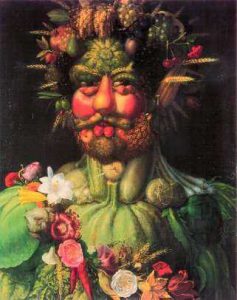Rudolph II
By Erin Naillon
Rudolph II was one of the most colorful rulers of Bohemia, and inadvertently, one of the most influential.
A Habsburg Ruler
Rudolph, a member of the House of Habsburg, was born in Vienna on July 18, 1552. The Habsburg family held the crowns of Bohemia, Hungary, and Croatia; it was also the family that ruled the Holy Roman Empire. At the age of twenty, Rudolph became the King of Hungary and Croatia. In 1575, he was crowned King of Bohemia. The following year, he ascended to the Imperial throne.
 Rudolph’s Art
Rudolph’s Art
He was intensely interested in art, as well as the occult and alchemy. As a ruler, he would invite various well-known people of the era to his court in Prague, which was the Habsburg capital from 1583 to 1611. He spent lavishly on paintings and other works of art, gathering what was the most impressive art collection of his time. His court included astronomers Tycho Brahe and Johannes Kepler; English poet Elizabeth Jane Weston; and astrologers Edward Kelley and John Dee. Arcimboldo created a memorable painting of Rudolph as Vertumnus, the god of the seasons in Roman mythology. The image is that of Rudolph – but comprised of various fruits, vegetables, and flowers. Rudolph may have had the most impressive court of any Bohemian ruler.
Rudolph’s Policies
Surprisingly, Rudolph had a very tolerant view of other religions. He tended to take a neutral stance in religious conflicts. Unfortunately for Europe and for Rudolph, he embarked upon a crusade against the Ottoman Turks in 1593. The long and bloody war dragged out into the new century, not ending until 1606. This war marked the beginning of the end of Rudolph’s reign.
Power Surrendered
In 1604 the Hungarians staged a revolt, being thoroughly fed up with the Long War, as it was called. In 1605 Rudolph’s brother, Matthias was given control over Hungary by Rudolph, at the insistence of the Habsburg family. Matthias managed to broker peace with the Hungarian rebels in 1606, much to Rudolph’s indignation. The Emperor then made plans to go to war with Turkey yet again. Matthias, however, gained support from the Hungarians and forced Rudolph to hand over the Hungarian, Austrian and Moravian crowns to him.
Bohemian Uprising
In 1609, in the midst of this family/European struggle, Protestants in Bohemia seized the opportunity to insist upon greater religious freedom. Rudolph, who had never had a problem with Protestantism, gave them the freedom they demanded in his 1609 Letter of Majesty. When the Protestants asked for even more rights, Rudolph brought out the army to quell them. The Protestants then turned to Matthias for assistance. Matthias’ own army kept Rudolph a prison in Prague Castle until 1611. That year, Rudolph gave the rest of his power to Matthias, under duress. Nine months later, in 1612, Rudolph died. Less than a decade after his death, the Bohemian Protestants, in an attempt to maintain the rights granted by the Letter of Majesty, stormed Prague Castle and threw three men out of the window in the Defenestration of Prague.
Art and Architecture
Rudolph is responsible for building the north wing of Prague Castle. This was done not for purposes of defense, but simply to create space to house his enormous collections. During the Thirty Years´War, the collections in the Castle were looted by Swedish troops, who took many pieces back home with them. Some of them were sent to Vienna approximately fifty years after his death. The magnificent collections, so vast that an entire castle wing was built to house them, were no more.
Influence
Rudolph is largely responsible for creating the image of Prague as a place of magic and alchemy. The legendary Rabbi Low was a visitor at Rudolph’s court; alchemists were often invited to Prague; the narrow, cobbled alleyways still breathe the mysticism of the late sixteenth century.



